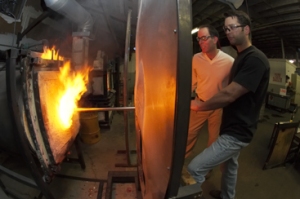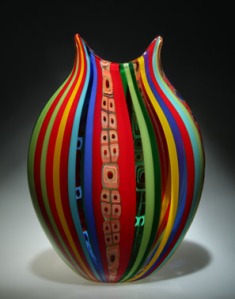 I recently met with David Patchen, one of San Francisco’s premier glassblowers. He was one of the featured artists on a tour that I co-hosted of San Francisco studios in the ArtSpan Tour des Artistes program. Interviewing David was a little bit different for me than some of the other interviews that I have engaged in. Usually I throw out questions and allow the interview to develop organically. Often I enter the interview with only a vague idea of what I will write about, often moving in an unexpected direction. However, with David the interview was more participatory. It felt more like a panel discussion than an interview. And the subject of the panel discussion was “craft versus art”.
I recently met with David Patchen, one of San Francisco’s premier glassblowers. He was one of the featured artists on a tour that I co-hosted of San Francisco studios in the ArtSpan Tour des Artistes program. Interviewing David was a little bit different for me than some of the other interviews that I have engaged in. Usually I throw out questions and allow the interview to develop organically. Often I enter the interview with only a vague idea of what I will write about, often moving in an unexpected direction. However, with David the interview was more participatory. It felt more like a panel discussion than an interview. And the subject of the panel discussion was “craft versus art”.
Back in the day, when I was studying Japanese art history in graduate school, I was very drawn to the traditional crafts, particularly pottery. One of the things that I loved about craft in Japan was the over-arching importance of technique. Technique was instilled in a very traditional, very rigid apprenticeship system. If you wanted to become a potter, you started by kneading clay until you could do it perfectly. Then, you made teacups until you could make those perfectly. And so on and so forth. Becoming a craft master was a long, arduous process, often taking literally decades. When you see some of the twisted, distorted pieces that are so valued in Japan, there is certainly an element of “accident” that is incorporated in those works. They are, however, a result of “accidentally on purpose”. Before there are departures from perfection, first there is a mastery of perfection.


David’s work is an exploration of the unique properties of glass. He is fascinated by its physical properties. The move from solid to molten and back to solid is an intense one. The window for creation is very constrained. It requires meticulous planning and attention to detail. But the rewards are great. The best of his works bend color and light in an almost magical way. David, himself, describes it best:

While varied in composition and design, I most often create work within a series of graceful forms which I consider three dimensional canvases. The diversity and variation in my work reflects my desire to explore a variety of ideas simultaneously. Some visual themes that recur include windows with views into or through a piece, contrasting transparency and solidity and disrupted repetition. Colors in contrasting and/or complimentary tertiary tones woven into complex patterns challenge expectations of the amount of detail glass can carry and its place in the art world.
This year, David has been selected for an artist residency by the Seto City Art and Cultural Foundation in Japan. Seto is one of the most historically important centers for the manufacture of pottery in all of Japan. In fact, the name “Seto” is synonymous with pottery. It  will be fascinating for me, personally, to see how this residency resonates in David’s future work. Will his work become even more precise; or will we start to see some more “accidentally on purpose” elements surface? Time will tell.
will be fascinating for me, personally, to see how this residency resonates in David’s future work. Will his work become even more precise; or will we start to see some more “accidentally on purpose” elements surface? Time will tell.
David Patchen is represented by numerous galleries nationally. Here in the Bay Area, you can find his work at Gump’s. This fall, he will be showing his work at Public Glass during San Francisco Open Studios, the weekend of October 24th -25th. As for those of you seeking immediate gratification, this Labor Day weekend (Saturday-Monday), he will be across the Bay at the Sausalito Art Festival, in booth # 131.
Filed under: Artist Profile, David Patchen, San Francisco Open Studios, Tour des Artistes | 3 Comments »


